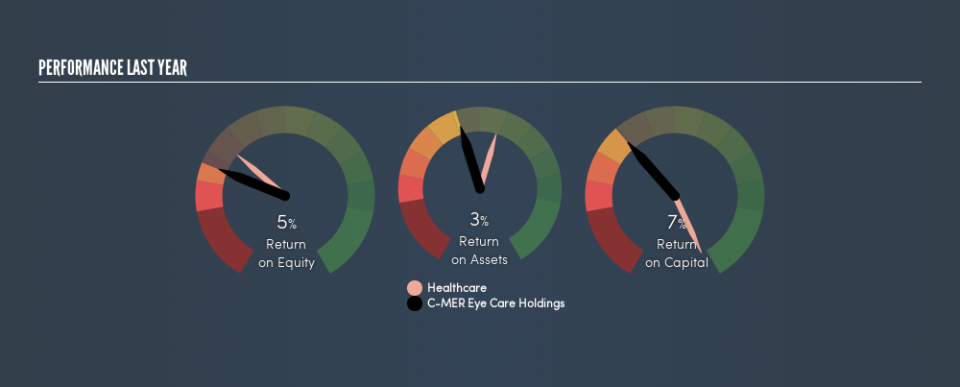Why C-MER Eye Care Holdings Limited’s (HKG:3309) Use Of Investor Capital Doesn’t Look Great

Want to participate in a short research study? Help shape the future of investing tools and you could win a $250 gift card!
Today we'll evaluate C-MER Eye Care Holdings Limited (HKG:3309) to determine whether it could have potential as an investment idea. Specifically, we're going to calculate its Return On Capital Employed (ROCE), in the hopes of getting some insight into the business.
First up, we'll look at what ROCE is and how we calculate it. Second, we'll look at its ROCE compared to similar companies. Last but not least, we'll look at what impact its current liabilities have on its ROCE.
Understanding Return On Capital Employed (ROCE)
ROCE measures the amount of pre-tax profits a company can generate from the capital employed in its business. Generally speaking a higher ROCE is better. Overall, it is a valuable metric that has its flaws. Renowned investment researcher Michael Mauboussin has suggested that a high ROCE can indicate that 'one dollar invested in the company generates value of more than one dollar'.
So, How Do We Calculate ROCE?
The formula for calculating the return on capital employed is:
Return on Capital Employed = Earnings Before Interest and Tax (EBIT) ÷ (Total Assets - Current Liabilities)
Or for C-MER Eye Care Holdings:
0.07 = HK$59m ÷ (HK$887m - HK$51m) (Based on the trailing twelve months to December 2018.)
So, C-MER Eye Care Holdings has an ROCE of 7.0%.
View our latest analysis for C-MER Eye Care Holdings
Does C-MER Eye Care Holdings Have A Good ROCE?
ROCE is commonly used for comparing the performance of similar businesses. In this analysis, C-MER Eye Care Holdings's ROCE appears meaningfully below the 9.5% average reported by the Healthcare industry. This performance is not ideal, as it suggests the company may not be deploying its capital as effectively as some competitors. Separate from how C-MER Eye Care Holdings stacks up against its industry, its ROCE in absolute terms is mediocre; relative to the returns on government bonds. Readers may find more attractive investment prospects elsewhere.
C-MER Eye Care Holdings's current ROCE of 7.0% is lower than 3 years ago, when the company reported a 66% ROCE. This makes us wonder if the business is facing new challenges. The image below shows how C-MER Eye Care Holdings's ROCE compares to its industry, and you can click it to see more detail on its past growth.
It is important to remember that ROCE shows past performance, and is not necessarily predictive. ROCE can be deceptive for cyclical businesses, as returns can look incredible in boom times, and terribly low in downturns. This is because ROCE only looks at one year, instead of considering returns across a whole cycle. What happens in the future is pretty important for investors, so we have prepared a free report on analyst forecasts for C-MER Eye Care Holdings.
Do C-MER Eye Care Holdings's Current Liabilities Skew Its ROCE?
Short term (or current) liabilities, are things like supplier invoices, overdrafts, or tax bills that need to be paid within 12 months. Due to the way ROCE is calculated, a high level of current liabilities makes a company look as though it has less capital employed, and thus can (sometimes unfairly) boost the ROCE. To check the impact of this, we calculate if a company has high current liabilities relative to its total assets.
C-MER Eye Care Holdings has total liabilities of HK$51m and total assets of HK$887m. Therefore its current liabilities are equivalent to approximately 5.8% of its total assets. C-MER Eye Care Holdings has a low level of current liabilities, which have a minimal impact on its uninspiring ROCE.
The Bottom Line On C-MER Eye Care Holdings's ROCE
If performance improves, then C-MER Eye Care Holdings may be an OK investment, especially at the right valuation. But note: make sure you look for a great company, not just the first idea you come across. So take a peek at this free list of interesting companies with strong recent earnings growth (and a P/E ratio below 20).
If you are like me, then you will not want to miss this free list of growing companies that insiders are buying.
We aim to bring you long-term focused research analysis driven by fundamental data. Note that our analysis may not factor in the latest price-sensitive company announcements or qualitative material.
If you spot an error that warrants correction, please contact the editor at editorial-team@simplywallst.com. This article by Simply Wall St is general in nature. It does not constitute a recommendation to buy or sell any stock, and does not take account of your objectives, or your financial situation. Simply Wall St has no position in the stocks mentioned. Thank you for reading.


